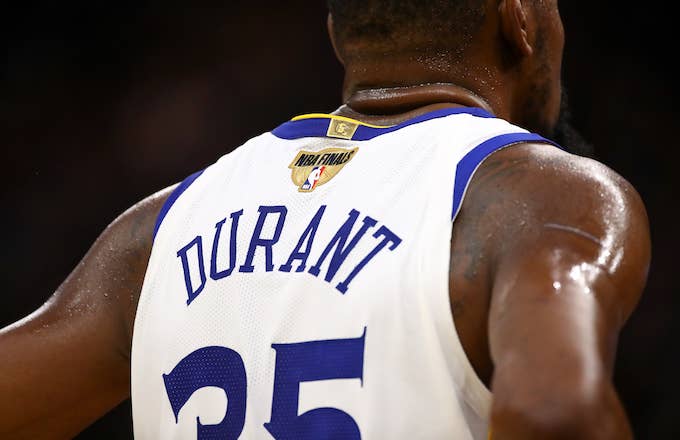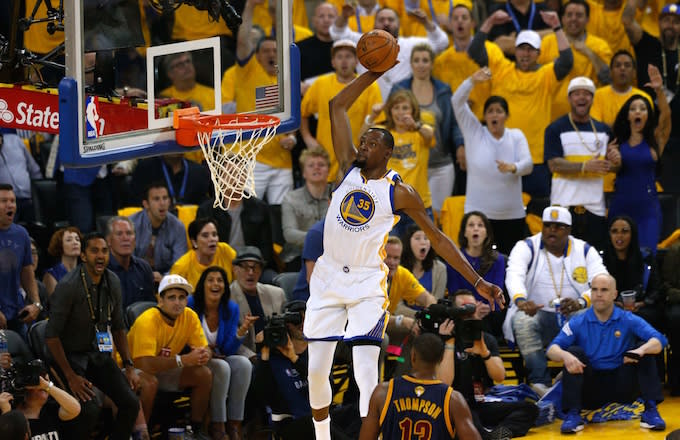
Forget the narrative ascribing timidity and laziness to Kevin Durant’s league-shifting decision two summers ago. Or the condescending “blog boy” sentiments that have since come to define his new prickly persona. Ignore the fact he’s not the best player in the NBA, and not even the most important player on his team. Overlook, for a moment, that Durant’s inadvertent disclosure of his burner account aligned with all the armchair analysis when he changed teams. (KD’s been playing basketball his whole life; is it any wonder he’s still figuring out who he wants to be?) None of that chronicled claptrap matters, though. Not for this question: Who is the greatest scorer in NBA history? It has to be Kevin Durant.
Before they finish reading the tweet, or headline, stans from a certain generation will be typing MICHAEL JORDAN in all caps. For them, any other answer is unfathomable; His Airness will always be the GOAT, especially when it comes to getting buckets. MJ's perfection in June, as well as the numbers (the rare 90s star whose efficiency translates to the analytics era), overwhelm almost every argument against. He led the league in scoring 10 times in his career, including seven straight before his first retirement; His one-man bucket bonanza in 1987 remains the highest points-per-game average (37.1 without averaging even one 3-point attempt a game!) in the shot clock era, a mark even Smush Parker-era Kobe Bean Bryant couldn’t eclipse. MJ proved you could win rings and scoring titles, too, securing both distinctions in all six seasons he won a chip.
When Father Time showed up, MJ adapted his offensive game, developing the most diabolical turnaround jumper the game had ever seen (apologies to Bernard King—Google him if you don’t know) while on the set of Space Jam. Except, through no fault of his own, he’s from a different era. One that forced him to chisel his skinny, 6’6” frame into an armor of muscle to overcome the physicality of Detroit’s Bad Boys. He didn’t need to develop a 3-point shot; that’s what Steve Kerr was for. NBA teams didn’t have analytics departments when Jordan was playing. At the time of his reign, Rockets GM Daryl Morey was getting a computer science degree from Northwestern and an MBA from MIT. The 3-pointer’s relevance hadn’t yet reached the mainstream, or even the periphery, so MJ didn’t get to capitalize on its inherent mathematical advantages (he could have, though—just ask any NBA fanatic born in the 70s or early 80s).
No current NBA player has as many scoring titles as KD, and only his teammate in Golden State can match his true shooting percentage while scoring all those points.
Kareem Abdul-Jabbar had the most unstoppable move in NBA history, the skyhook, and warrants more than a minor mention as the league’s all-time scoring leader. But the man whose physical gifts led college basketball to doing him dirty when they outlawed dunking in 1967 was from a completely different era, one you can find only slight vestiges of in today’s game. The league has mutated so drastically in such short periods of time. The most dominating center of the late 80s and early 90s, Hakeem Olajuwon, had a completely different game and body compared to the most dominant center of the late 90s and early aughts, Shaquille O’Neal. Both were unstoppable champions, but in a wholly different game, one that still resisted the line that’s refashioned the kinesiology on the court.
For the the generation after MJ’s deification—Durant’s generation—Bryant is the only answer when asking about the game’s best scorer. And that answer is usually followed by a snicker that you’d even have the temerity to ask. Kobe is MJ, but with 3-point range. He’s the natural conclusion to the game’s perimeter evolution. He might be more psychotic, too (you could make the case Dexter had Mamba Mentality). Except Bryant is also 6’6” and has a lower career 3-point percentage (34 percent) than Carmelo Anthony (34.5).
LeBron James is listed at 6’8”, but built like a tank. He also checks off almost all the offensive boxes. He’s become a near-automatic double in the post, the absence of which was his cause celebre before finally winning a chip. But he went and trained with Olajuwon, and now he can muscle into a drop step that’s—with those elbows and his frame—impossible to stop.
James has the brawn and the brains, and a ridiculous bag of shots to choose from, including the occasional Steph Curry dagger from deep, the turnaround fadeaway where he’s near midcourt when it splashes through, and the full-court sprint as time expires into a bank shot as he’s falling out of bounds. But he’s not a natural shooter. The ball doesn’t effortlessly roll off his fingertips and shoosh the net. Jump shots are work for LeBron. That’s why Gregg Popovich, with a hat tip from Kawhi Leonard, forced him to make jumpers for Miami to barely eke out the 2013 title (and he didn’t really start to trust his jumper until the second half of Game 6). Since then, the career 34.4 percent shooter from deep has turned into a viable threat behind the arc (over 40 percent in his last MVP season—2013—and right around league average the last two seasons in Cleveland.) But that’s not good enough to best Durant in this debate.
We know Durant will never be LeBron’s equal as a playmaker. KD’s not throwing those blind, cross-court dimes right in the corner shooter’s pocket when the double comes on his drive, or those Houdini pocket pass that squeez through an opening only Rajon Rondo and Bron can see before it closes again. James might be the greatest offensive force in the history of basketball, part Magic Johnson, part Michael, part Dream. He is this generation’s best player and in the running for GOAT status. Yet he can’t score like Durant.
Neither can Steph, or James Harden, or Russ Westbrook. Curry is too slight, despite a 2016 season that might be the best offensive season in NBA history, and a 3-point percentage—on an absurd 7.8 attempts per game for his career—that’s never fallen below 41.1 percent for a season. But at 6’3”, 190 pounds soaking wet, Curry can be physically overwhelmed. It’s the biggest reason Golden State flew to the Hamptons to court Durant in the first place.
As for the 2018 MVP, Harden possesses a ton of wiggle, and a shiftiness in the pick-and-roll defenders are hopeless to stop when Houston has three shooters on the weak side. He’s nearly James’ equal as a passer, and his yo-yo handle, preternatural spatial awareness, and freakish ability to decelerate means he’s living in the lane or at the line no matter who defends him on the perimeter. The Beard’s step-back 3-pointer is deadly as well, but—similar to Steph—he’s not 7-feet tall, even if he’s a lot more solid than Steph will ever be.

Westbrook’s offensive game is a snarling siege on the rim. He’s so athletic that when he gives himself that long runway behind a screen, no matter how far defenders drop, they might as well concede a layup or a trip to the stripe. But Westbrook’s why not ethos extends to his shot selection, where he’s never shot better than 34.3 percent beyond the arc despite attempting over seven threes a game that season. In a quiet moment away from their fellow denizens, OKC fans will admit as much. It’s why Durant’s parting stung like it did.
While KD’s retreat from what Sam Presti tried to build in OKC adds an asterisk for many to his post-OKC numbers, the move broadened his already elite offensive game. Golden State is where Durantula mastered his movements off the ball. The Thunder’s remedial sets with zero counters forced Russ and KD to take turns scoring at the end of games. It’s a big reason they could never get a chip and have failed to advance in the playoffs since KD’s departure. While necessity of personnel allowed Durant to turn into a better ball handler and shot maker, especially when Russ missed time during Durant’s 2014 MVP campaign, it stunted his growth off the ball. Opponents could see that ubiquitous pin-down they’d run from a mile away.
As a consequence of the bland play-calling, defenses were keyed to stop him. Yet, we forget just how good Durant was without the Splash Brothers to keep help defenders at home on the arc (Russ certainly wasn’t enough of a catch-and-shoot threat to do so); Even without the 2017 MVP, Durant excelled. In 2014, with Russ missing half the season following knee surgery, Durant shot an incredible 41.4 percent from three where he took seven or more dribbles, and over 40 percent when he dribbled it three to six times. To put that in perspective, Curry didn’t shoot that well after seven dribbles when he unanimously won the 2016 MVP. Durant was in the 85th percentile for isolation points per possession (PPP) in his final year with OKC, and the 87th percentile as the pick-and-roll ball handler—even while struggling to keep his turnovers down (you try keeping a tight handle when you’re that tall).
No current NBA player has as many scoring titles as KD, and only his teammate in Golden State can match his true shooting percentage while scoring all those points. He can score on a pick-and-pop along the arc, or in the mid-range, which might be a no man’s land in Morey’s world, but speaks to how impervious Durant is to an opponent’s defensive scheming. He can spread the floor and score from the top of the key, or in transition on the break. Run him off the arc and he’ll just score at the rim, where his 7’5” wingspan is even more impossible to stop. Defend the rim and the arc, and he’ll relish swishing the one-legged step-back like a Dirk Nowitzki mirage.
Kevin Durant will go down as the best scorer in NBA history. If he isn’t already.

